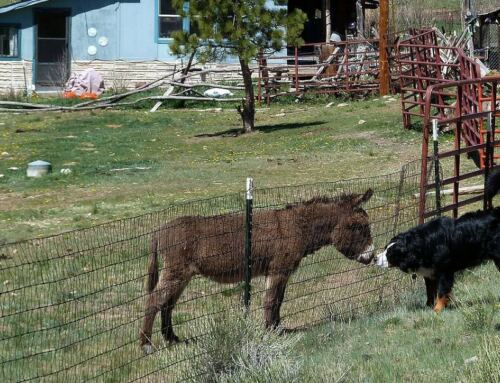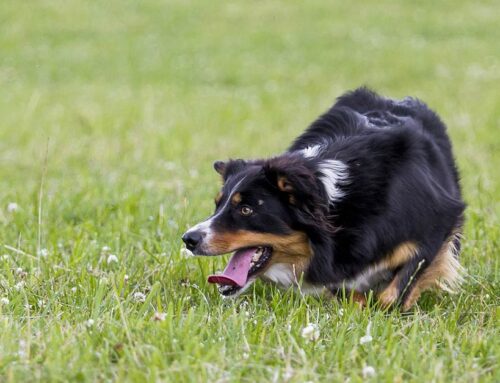There are some things I take for granted, things that have become part of the fabric of my life with dogs, that I forget that at one time they were new ideas to me. Creating conditioned reinforcers to use in a variety of ways with my dogs is one of them. Here’s a quick primer on what conditioned reinforcers are, how you create them and what you can do with them.

Cues can become conditioned reinforcers too!
A conditioned reinforcer is anything that is paired with a primary reinforcer, often food, in a way that imbues the conditioned reinforcer with the impact of the primary reinforcer. The conditioned reinforcer causes the dog to feel the way they feel about the primary reinforcer. The sound of the clicker is a conditioned reinforcer. There are other names for conditioned reinforcers, such as secondary or tertiary reinforcer, but all are conditioned reinforcers. A conditioned reinforcer, before it’s been conditioned, or the dog has learned to make the association between it and the primary reinforcer, has no intrinsic value or does not necessarily create a positive emotional response in a dog. The sound of a clicker, the words “good dog!”, a dog’s name, have little or no meaning to a dog, but we can change that. Once we do, a conditioned reinforcer can be a powerful tool in training a fearful dog.
The way we can create conditioned reinforcers is simple, we follow the presentation of whatever we want the dog to feel good about, with a food treat, repeatedly. The dog hears, sees, feels or smells whatever we are conditioning them to and they anticipate a treat will follow. Eventually, even if a treat does not follow, once something has been conditioned, the good feeling occurs. For years an aunt would send me a birthday card with a check in it. The check, also a conditioned reinforcer, made me feel good. When I would open the mailbox and see an envelope from my aunt, I would feel good, even before I opened it. When I got older the checks stopped coming, but before I realized that the routine had changed, I still got that oh goodie a check feeling, when I saw the envelope.
Dogs fearful of people need to be taught that certain things should feel good to them, unlike dogs who grew up having positive interactions with people from puppyhood on. Praise or petting, which can be reinforcing for many dogs who have positive associations with people, are not necessarily loaded with enough of the feel good effect to cause a fearful dog to work for them. By following words of praise, ear scratches, a smile, your dog’s name, or clapping your hands with a treat, you will have a variety of things you can use to make your dog feel good. If something makes a dog feel good enough, they will try to figure out what they did to make it happen, so they can do it again. This is how we train dogs to do all kinds of things.
How can you use conditioned reinforcers? They can be used as rewards to reinforce behaviors in dogs we would like to see more of as I’ve described above. We can also use a conditioned reinforcer to mark a behavior to point out more clearly to the dog what it is we are rewarding them for. This is how the clicker is typically used. When teaching my dogs to take a nap, I can mark, with either a click or a word, when they lower their head. Then I toss them a treat. In training this is the deal I make with dogs. They do something, I point it out with a conditioned reinforcer and then I give them a treat, or other primary reinforcer. For some dogs the opportunity to chase a ball or play tug, can replace the food.
A third way to use conditioned reinforcers with fearful dogs is to use their value to change how a dog feels about an event or trigger. Take a phrase, silly boy, for example. Say it and then give your dog a treat, over and over again. The next time something spooks your dog and they startle or cower you can tell them him he is a silly boy, and if he is not too terrified the words can help change how he feels. Some people call this jollying.
I use conditioned reinforcers to help scared dogs stop being scared of me approaching or being near them. I pair my arrival with a conditioned reinforcer, often the click of a clicker, and follow that with the toss of a treat. So long as the dog is happy to hear the clicker, go after a treat, my arrival predicts both of these will occur. This is not the same as having a treat predict the appearance of a trigger, which can ‘poison’ the value of the treat. This is an important distinction to make. Think about luring a dog into the bathtub with a piece of bologna. Imagine how the dog will respond the next time you try to lure them anywhere with bologna. You don’t want this to happen with your conditioned reinforcer.
Pick a few things you can turn into conditioned reinforcers for your dog. Choose words or actions you normally do without thinking about it. Is there something you say when a dog does something you like? Do you cheer or give your dogs a thumbs-up? Grab a bowl of their favorite treats, say it or do it and toss your dog a treat. Repeat until you use up the treats. During the next few days carry treats with you and do the same thing whenever you say or do what you are conditioning. You can work on several throughout the day; smile-treat, yahoo!-treat, good dog-treat, happy hand waves-treat, etc. You will be creating a collection of feel goods and if there’s anything a fearful dog needs, it’s to feel good.





